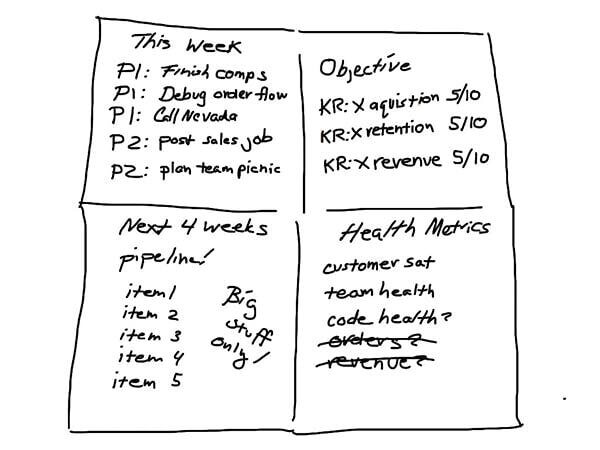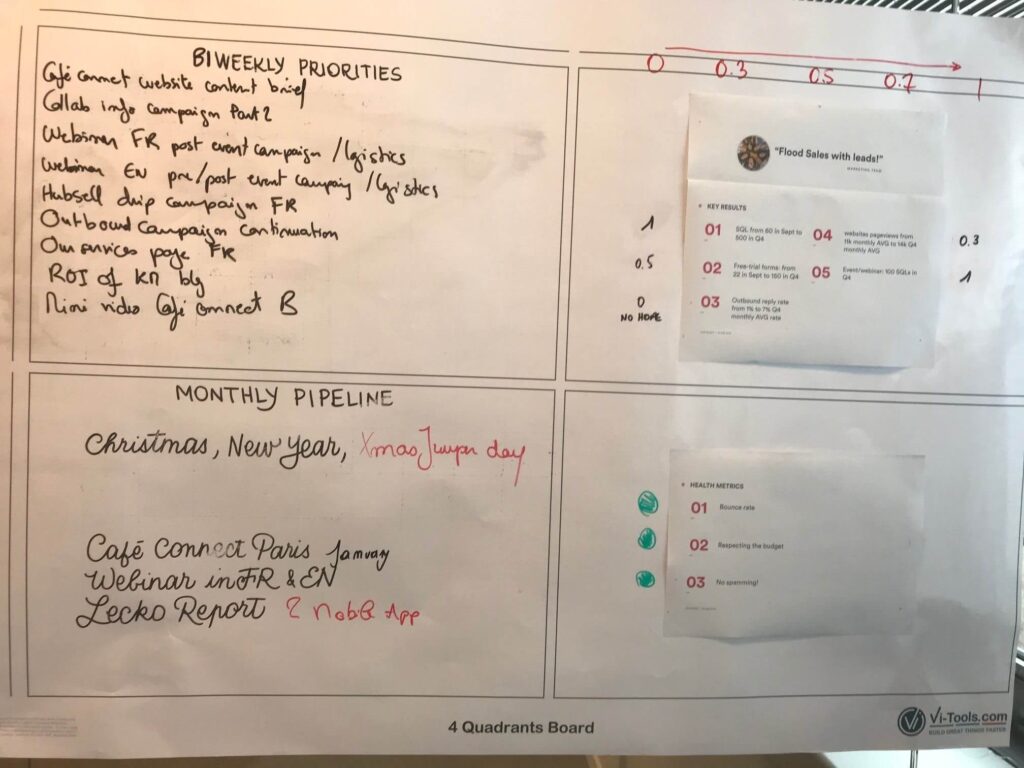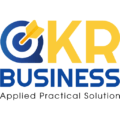Maybe you’re still playing with this idea because on every virtual street corner someone is talking about OKR, or your VC really, really insisting that you should try it, or you’re simply fed up with how people in your company seem to be working really hard in the opposite direction… in that case, I’m sure you’ll find some resonance in our story.
So we also decided to “try OKR” about a year ago, primarily with the goal of supporting our expansion efforts and continuing to adjust growing teams around our strategic goals. Basically, we want to turn the strategy into well-directed action.
Study in #1: “Home exercises in front of the frame”
Since Andy Grove promoted this vision at Intel, and since it was chosen by the Valley’s most famous entrepreneurs, it may well have become the second-largest movement at the height of Palo Alto (which of course Flower Power still leads the 😉).
So we delve into some references and do our home workouts: we read Christina Wodtke and just love her OKR beer card (help if you’re Belgian 🇧🇪), we’ve appreciated lean guru Felipe Castro’s accessible style, we were surprised by Larry Page’s iterations at Google to push a billion-dollar company to achieve its goals.
There’s enough passion in the boardroom to come through with it.
A small summary for those less familiar with the method: OKR (short for Key Goals and Results) is a framework for setting goals in line with strategic, tactical, and organizational activities. Goals translate your goals, the overall goals you’re trying to achieve. The theory wants it that you should frame them in inspirational and ambitious words since shooting for the moon will surely take you somewhere between ✨
It goes something like: “Flood the sales team with a tsunami of qualified leads!”
As a romance, key results mean keeping both of your legs on the ground, they are dosing indicators that show you when you reach your goal. They go something like: generate 1000 sales-eligible leads, achieve a 5% overseas response rate, generate an additional 100 SQL through webinars…
After many challenging discussions with the Senior Management Team, we decided to implement the following framework:
- 3-4 OKR strategy /yearly to sort people out about the company’s priorities
- 1 tactical OKR per team/activity per quarter to focus effort
We want to start in a “gentle” way, so as not to overload the process. So we didn’t start with individual OKR to continue focusing our team’s efforts on the company’s key goals.
This setting gave us about 35 goals to identify, manage, and track during the year. The limited number of goals allows you to keep a full overview and it can still manage to track &change if necessary.
Learn #2: “Alignment before identification”
It all seems very simple. And frankly. And we all know what’s important to the company, right? And we are a group of intelligent men and women, so how difficult is it to identify 3-4 OKR strategies together?
We confess, for the first time, it took us a few long iterations to pin our annual strategic OKR with the Management Team. Each Head of Department has a pretty clear vision of what needs to be accomplished in the teams, but we find it quite annoying to integrate all our different visions into a range of goals that should literally boost the energy and efforts of everyone in the company.
Since teamwork is at the heart of our culture, we decided to move this to our OKR approach: Strategic OKR is defined in workshops with the Senior Management Team and the CEO. The strategic OKR is then presented to different Teams who are tasked with defining their quarterly team OKR so that it plugs right into the strategy.
Iterations required to identify the first quarterly group OKR are as much as those of the executive team. When we refer to the process of setting more “traditional” goals, we find that in many enterprise environments it is still the result of a bilateral discussion between N and N-1 (all paths down the pyramid) and different group goals that are not always communicated with other departments.
Luckily for us, at Elium, we happened to develop a tool that shares ace knowledge, and the communication problem of setting goals is not really one for us. Thanks to Elium, all our OKRs are public and up to date. One thing to worry less about 😉. If you are curious about how our team defines their goals and tracks them, just check out our homemade samples here.
However, we learned the hard way is to decide TOGETHER about our most important challenges just an easy process. But by talking about them, we must feel the true linking power of the method.
And we’re getting better about it, too. Every quarter we have time in setting our Goals and people become more mature and skilled in setting goals. Don’t be discouraged if the first rounds seem a bit tedious, give your organization some “rings” before it opens up the real power of OKR.
LEARN #3: “Rhythm before the process, Try the tool in advance”
Well, there are some pretty interesting OKR tools out there! But when we were also captivated by the interesting features and vague promises of the effectiveness of our companies, we really went back to the “root” approach that Christina Wodtke said in her much-acclaimed book “Radical Focus.” Any OKR can hold a beer card!

So we started tinkering with this genius idea and created our own giant beer cards:

We still need to find our OKR line. The goal is just a bunch of words on the whiteboard unless people start caring about them and building their actions around them. So we start with the “Commitment Monday – Friday Win” cycle for all teams.
“Monday Commitment“: at the beginning of each week, teams gather around the whiteboard and determine what will be their most important action this week. They look at what’s ahead and prioritize activities that are likely to have the most important impact on Key Results. They talk about their confidence levels, check if the Group’s Health Index is controlled, and find energy and comfort in interactions. And they attacked during the week!
“Friday for the winners“: when you shoot for the moon, you will face a lot of failures… So it’s important to get together with the team and celebrate every step ahead. Friday is about ending the cycle, about assessing what goes well and what doesn’t. Friday’s lessons show us to focus on impacted actions and drop all the rest!
But after a few weeks, the first rhythm changes were made: the Engineering team needed better links with the Products team and their Scrum rituals, and they decided to carry out OKR monitoring and every two weeks: commitments integrated with the sprint plan and reviews were carried out during the res recall. The Marketing team, who are also Scrum fans, go the same way.
Sales, by contrast, needs to speed up the weekly rhythm and add (shorter) daily updates to make sure everyone matches the numbers. We have carefully allowed those small adjustments to keep the process alive and suitable for different groups.
We only have two recommendations to keep a common OKR practice link in the company:
- The end of the quarter was a difficult milestone for everyone, we assessed the effectiveness of all teams and also of the company
- Each team should make sure to keep a stable OKR pulse that allows it to adjust its actions in time when things don’t go as planned. The level of “timely” is left to the good judgment of the teams.
A year later, we still don’t have the OKR tool, as we still have the same number of goals per year and we manage quite well. We created an OKR template on our Elium platform, so teams easily create and share their Goals using the same model and solution that’s doing the job.
LEARN #4: “Work hard before results”
“yes, so we didn’t nail our first OKR …” Need not say, we missed the first rounds. So it makes us doubt about okr at the same time. Only until finally, we manage to pull out a big product change for a new market. It was only when we reached our biggest contract in 2 years.
It was only when we held the biggest branding event we ever did….
Looking back, we never really failed at OKR, we were just very busy participating in the movement. We learned to identify priorities, commitments, and not shy away when things get tough. We learned not to blame each other for lack of results and challenge ourselves to go beyond easy reasons and solve new obstacles. We grew up talking about goals because people can’t play around with people’s motivations.
At the end of the day, it’s all about the motivation of the team and the main goals, and whatever’s between them.
LEARN #5: “Mission ahead of strategy”
The most difficult part of the process is going into a full circle, starting from scratch each year to identify the new strategic OKR. Once the freshness wears out, and the taste of the experiment has given way to a heavier sense of collective responsibility, organizations face the rudimentary truth of identifying the right goals that contribute to the sustainability of the company.
And that any company – even startups – should have a long-term plan (er) that contains more than some vague business hypothesis. So we were stuck in the face by our outdated mission statement. That hurts.
And we went down to it. It wasn’t a pleasant trip, recreating itself brought as much darkness as excitement to the journey. The whole effort has driven us straight into an important business axis, transforming our target market and adapting our entire internal organization to it. We’re not there yet, but we’re still on the move!
And that may just be the essential value of the entire OKR process, after the initial glitter wears out and you discipline yourself to proceed, your company is offered a real dive into the cycle of creating its own value.
And once you plug in, OKR is your best ally to start creating clarity around your most important goals and expectations.




